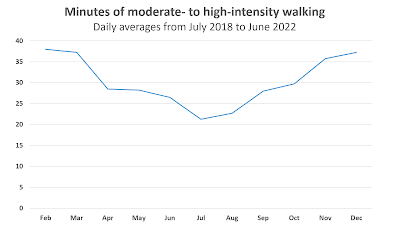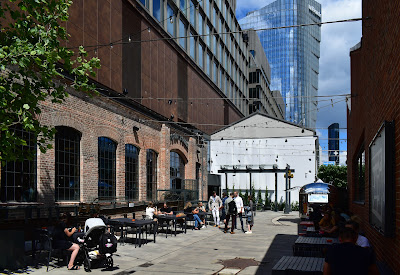The sun rose over Warsaw today at 04:14, it's earliest in the year (indeed it rises at 04:14 from the 12th to the 23rd of June; the latest sunrise - at 21:01 - is on 21st to the 28th June, making the 22nd the longest day). Making the most of the public holiday (Corpus Christi), I woke up this morning just after 3am, dressed and ate breakfast, leaving the house in Jeziorki bound for Jakubowizna on foot. Temperature was a cool 9C, thin jacket required.
Below: in case anyone wants to know what quarter past three in the morning looks like in suburban Warsaw in mid-June, here we are - view from my bedroom window. Untweaked in Photoshop - out of the box. Light mist on the meadow behind the house.
Below: end of my street, junction with ulica Karczunkowska. I'm on my way. No traffic - public holiday as well as being really early!

Below: the pond on ul. Pozytywki, ducks and coots still asleep. Nothing stirs. One dog barks nervously.
Below: still incomplete, the new Orthodox church on ul. Puławska catches the rising sun. This is Warsaw's Hagia Sophia, belonging to the Polish Autocephalous Orthodox Church (nothing to do with the war criminal Patriach Kirill). Modelled on the one in Constantinople. It stands just metres from Warsaw's southern border (this side of the treeline).
Onward through Mysiadło to Piaseczno, the Slough of the East. Not my favourite Polish town, though I must say, that like many places right now, it is currently undergoing a thoroughgoing modernisation. Below: work under way, roads closed - an early bus runs empty across (Piaseczno's) ul. Puławska. Photo taken one hour after leaving home. I look forward to seeing Piaseczno when all the work's been finished. Looks promising. Proper provisions for cyclists and pedestrians.
Onward, south to the edge of Piaseczno, over the footbridge crossing the river Jeziorka (nothing to do with Jeziorki) and into Żabieniec, still noted for its fishponds (farmed carp) and the freshwater fish institute (Instytut Rybactwa Śródlądowego). The ponds are a landmark when flying into Warsaw Okęcie airport, to the left of the flightpath.
Having passed through Żabieniec, I enter the Chojnów landscape park (Chojnowski Park Krajobrazowy) - the best part of the trip. After a while, the footpath joins the Gościniec Wareki (the archaic word gościniec is akin to the English 'highway' in the historical context - think of 'highwaymen'). The road runs south; to the west the fishponds, and the Warsaw-Radom railway line - audible but not visible. Below: bliss - two hours' walk from home. About one-third of the way.
Having crossed the road to Zalesie Górne, the Gościniec Warecki becomes asphalted. Cars are mercifully rare - on this seven-kilometre stretch, I saw just two (and two cyclists, two dog walkers and one deer). Below: the curious settlement of Nowinki (lit. 'Little Tidings' or 'Little Novelties').
What makes Nowinki (at least its northern end) unusual is the character of the buildings - działki set back from the road, modest wooden shacks mostly, neglected, yet fenced off with concrete posts and barbed wire, surrounded by tall trees. The hallmarks of a communist-era enclave - a rural retreat for middle-ranking apparatchiks. Having retired and or died off, their działki have become terminally shabby. No one claiming them. Further on up the road, new houses are appearing - brick-built and without the paranoid fencing.
Time for a second breakfast and a ten-minute rest at the three-hour mark between Nowinki and the next village along - Krępa, at the southern edge of the forest. The Gościniec Warecki gives way to ul. Długa. Krępa was much prettier, brighter and better looked-after than Nowinki - pavements, notice-board, well-kept houses.
Leaving the forest behind, my next waypoint is the Skierniewice-Łuków railway line, which crosses the main Warsaw-Radom line at Czachówek. Like the locals, I avoid a half-kilometre detour via a road tunnel under the tracks by using an unofficial but well-worn path over them. Having just seen (in the distance) two passing container trains heading east-west and west-east, I knew the coast would be clear for a long while. In the distance, the
Czachówek diamond.
South of the line, I feel I'm almost home in Jakubowizna. But it's still a long walk to Sułkowice. On one side of the road flows the Czarna river, floodbanks on either side protecting adjacent lands. Coming up to 9am, but still very few cars on the road.
Below: a footbridge over the Czarna, leading to Czachówek Południowy station.
Below: another curiously named settlement along my route - Kiełbaska (lit. 'Little Sausage'). Untouched by progress.
Soon, I arrive in Sułkowice - famous for being home to Poland's police-dog training school. Past the village and station, the DK50 viaduct on the horizon means I'm no more than 20 minutes from home on the
działka. Rushing through (non-stop between Warka and Piaseczno) is the 'San' express.
It's good to know that I can get to the działka under my own steam - ended up spending no money today (all shops along the way firmly shut) - walking 26.4 kilometres (16.4 miles) with six or seven kilo on my back.
Arriving on the działka, time for a wash, a beer - and a nap (which ended up being two hours long!). But then I only slept five hours, so I needed it. A total over over walked 36,500 paces today.
This time seven years ago:
Central Warsaw rail update


















































